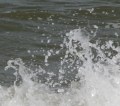 To predict the height of crests and the depths of troughs of ocean waves, scientists can turn to the well-known work of German mathematician and scientist Johann Carl Friedrich Gauss. The so-called Gaussian function provides a mathematical formula from which one can determine the normal distribution of wave heights based on probability theory and statistics.
To predict the height of crests and the depths of troughs of ocean waves, scientists can turn to the well-known work of German mathematician and scientist Johann Carl Friedrich Gauss. The so-called Gaussian function provides a mathematical formula from which one can determine the normal distribution of wave heights based on probability theory and statistics.
Gauss works very well in theory. But, don’t mention wave theory and normal distributions to workers on a platform in the depth of night in a raging North Sea facing an extreme storm threatening to tear the artificial patch of dry land from its moorings.
Instead, you might want to tell them about a new approach to predicting extreme wave heights reported this month in the International Journal of Reliability and Safety. In his report, Francesco Fedele of the School of Civil & Environmental Engineering, at Georgia Institute of Technology, accepts that nineteenth century mathematics is not enough even to address the timeless problem of extreme ocean waves.
He has now devised a formula for predicting possible outcomes given particular ocean conditions. The work could inform the design of ocean-based oil and gas platforms, marine wind farms and other large engineering structures at the mercy of the waves.
The Gaussian function works well with linear phenomena under ideal conditions and then only if it focuses on the most likely outcomes not the extremes. Fedele points out that ocean waves behave in a non-linear way and so don’t fit the Gaussian function well. Moreover, there can be extreme peaks that are not matched by extreme troughs and vice versa. It is more complicated a problem than Gauss can handle.
Fedele has now turned to an entirely different formula, Breitung’s asymptotic formula, that allows non-linear behaviour to be defined mathematically. The formula takes into account the random nature of ocean wave motion up and down, which can be affected strongly by wind, underlying currents, and the profile of the ocean floor.
Fedele and his colleague M. Aziz Tayfun from the University of Kuwait compared the wave data set collected at the Tern platform in the northern North Sea during an extreme storm in a recent article that appeared in the Journal of Fluid Mechanics (2009, 620, 221-239). The predictions offered by the new formula are much more prescient than a Gaussian formula and confirm the validity of the twentieth century attempt at ocean wave prediction encompassed by the Tayfun model.
![]() Francesco Fedele (2009). On the statistics of oceanic waves Int. J. Reliability and Safety, 3 (1/2/3), 258-266
Francesco Fedele (2009). On the statistics of oceanic waves Int. J. Reliability and Safety, 3 (1/2/3), 258-266